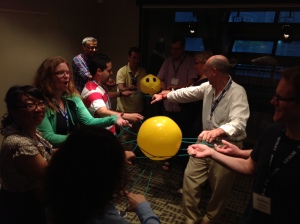
I love games for learning – playing about serious matters allows people to drop some of the filters and barriers that may unconsciously affect how group discussions unfold and really explore ideas. And the laughter and drama of playing a game that involves body, mind and emotions in order to learn about something helps ensure that the learnings stick.
At Play4Agile 2013, Markus Wittwer led an amazing and very popular game about team responsibility that explores the importance of shared intentions and playfully illustrates some of the effects of dysfunctional team behaviour. I ran the same game during the Friday night playdate at Agile Coach Camp Canada 2013, where the participants had a lot of fun and made several excellent suggestions for how to extend and improve it. Since then, I’ve been asked to share the exercise so that others can run it with their teams – here you go:

Time required: 15-20 min
Number of players: teams of 7, the more teams the better
Materials:
- big loops of rope – I bought 20M hanks of lightweight cord at a dollar store and cut it into ~6.5M long pieces. For bigger groups, you may want longer loops.
- beach balls – or other light balls (balloons, playground balls) roughly the size of a soccer ball.
The game:
- Participants arrange themselves into teams of 7 and each person grabs onto the loop with two hands. The team members should count off so that they know who is team member #1, team member #2,…through to team member #7
- Each team make a net with the loop by passing the rope to each other until a net is formed.
- Place a ball in the middle of each team’s net. The team’s work is to keep the ball in play on the net – don’t let it fall!
- The facilitator then guides the team through a number of actions/scenarios. In each scenario, the team follows the instruction and attempts to move gently around the room while keeping the ball in play. The facilitator may ask the team to return to a neutral state between scenarios (or not!):
- the team moves around, learning to keep the ball in play
- team member 1 takes 130% of the responsibility by pulling harder on the cord.
- team member 2 gives up some responsibility by loosening their grip on the cord.
- team members 3 & 6 have a conflict and try to pull apart while maintaining their grip on the net.
- team member 4 leaves their home team and joins another team
- team members 5 & 7 swap places
- multi-tasking!: have one team member join onto another team while remaining part of their home team
- remote team member: have one team member close their eyes
- have the team members move around silently
- have one team member remain immobile while the rest of the team moves around.
The debrief:
This is a really powerful game for dramatizing what happens when teams are not aligned in intent or are in a position where team members are distracted from the shared team goal by external factors. I think it works best if you debrief as you go: run one or two scenarios, then pause and encourage participants to reflect on how they are feeling right then, and how the current situation reflects circumstances that are present on their teams.
